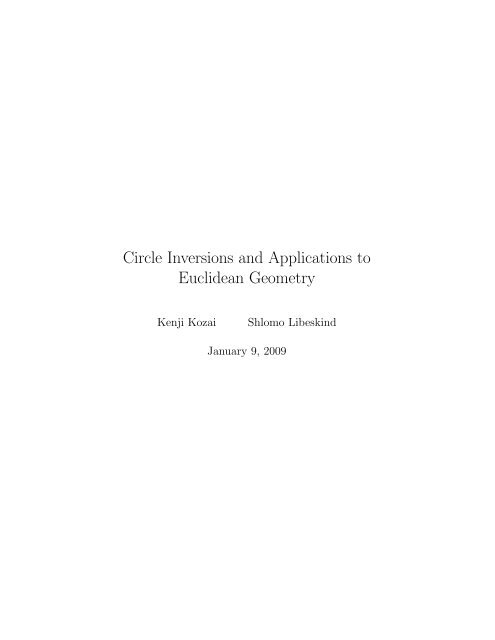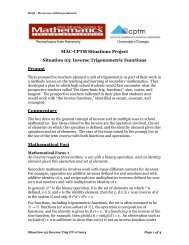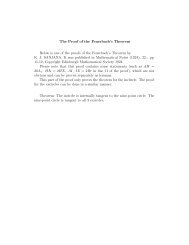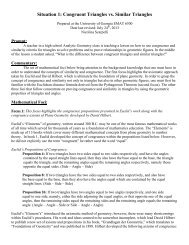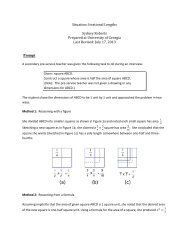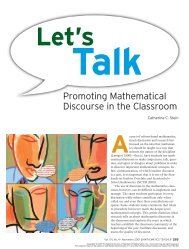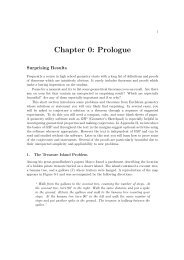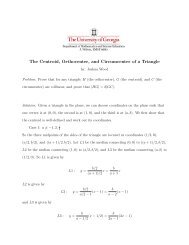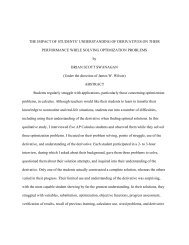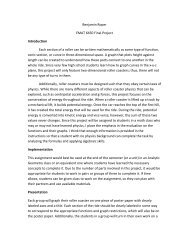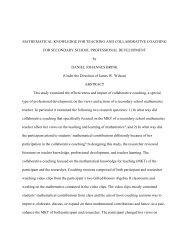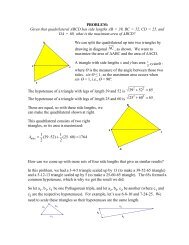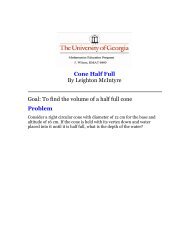Circle Inversions and Applications to Euclidean Geometry
Circle Inversions and Applications to Euclidean Geometry
Circle Inversions and Applications to Euclidean Geometry
- No tags were found...
Create successful ePaper yourself
Turn your PDF publications into a flip-book with our unique Google optimized e-Paper software.
<strong>Circle</strong> <strong>Inversions</strong> <strong>and</strong> <strong>Applications</strong> <strong>to</strong><strong>Euclidean</strong> <strong>Geometry</strong>Kenji KozaiShlomo LibeskindJanuary 9, 2009
Often, an inversion in a circle is referred <strong>to</strong> simply as an inversion. Noticethat points inside the circle <strong>and</strong> close <strong>to</strong> the center, O, get sent <strong>to</strong> points thatare very far away from the circle. In addition, it can be easily verified thatpoints on C are fixed by inversion in C. However, there is one point in theplane that does not have an image under inversion, O. As P gets closer <strong>to</strong> O,P ′ get farther away from O, so in some sense, we can think of O as mapping<strong>to</strong> a point at infinity. We will explore this in more detail in Chapter ??,with a geometric interpretation on the sphere. For now, we will say that thecenter of the circle of inversion, O, is mapped <strong>to</strong> a “point at infinity” on theextended plane, <strong>and</strong> O will be called the center of the inversion. Note thatif P maps <strong>to</strong> P ′ , then P ′ also maps <strong>to</strong> P . We say that P <strong>and</strong> P ′ are inverseswith respect <strong>to</strong> the inversion in C.Problem 1. Given a circle C with center O <strong>and</strong> a point P , we would like<strong>to</strong> be able <strong>to</strong> construct the image of P under inversion in C. We will do thisfor a point P outside the circle C.CbhaAb 1Da 1BcFigure 1: A right triangle ABC with b 2 = b 1 c.Investigation: Given a point P , we would like <strong>to</strong> construct a point P ′ suchthat OP · OP ′ = r 2 . This brings <strong>to</strong> mind the result from Euclid’s proof of3
O O 1 P R R'Q'QP'C 1CFigure 1.2: A circle mapping <strong>to</strong> a circle under inversion in C.By definition of inversion in a circle, OP ·OP ′ = OQ·OQ ′ = OR·OR ′ = r 2 ,where r is the radius of C. Thus,OPOQ = OQ′OP ′OROQ = OQ′OR . ′Since △OP Q <strong>and</strong> △OQ ′ P ′ share the angle ∠P OQ <strong>and</strong> the ratios of theadjacent sides are equal, they are similar. Likewise, △ORQ <strong>and</strong> △OQ ′ R ′are similar.Therefore, ∠OP Q = ∠OQ ′ P ′ . But ∠OP Q is an exterior angle, so it is thesum of the two opposite interior angles. Thus, ∠OP Q = ∠P RQ + ∠P QR.We also know that ∠ORQ = ∠OQ ′ R ′ since △OQR <strong>and</strong> △OR ′ Q ′ are similar.Hence,∠OP Q = ∠OQ ′ P ′∠P RQ + ∠P QR = ∠OQ ′ R ′ + ∠P ′ Q ′ R ′∠ORQ + ∠P QR = ∠ORQ + ∠P ′ Q ′ R ′∠P QR = ∠P ′ Q ′ R ′ .Angle ∠P QR is a right angle, so it must be that ∠P ′ Q ′ R ′ is also a rightangle.So far, we have shown that the image of every point on C 1 is a poin<strong>to</strong>n the circle with diameter R ′ P ′ . To show that image of C 1 is the entire11
Theorem 1.4. The magnitude of the angle between two intersecting curvesis not changed by an inversion.Remark: Notice that there are two angles between the two curves α <strong>and</strong> β.If one of the angles is δ, the other is 180 o − δ, so we can always choose theangle δ <strong>to</strong> be an acute (or right) angle.Proof. Let C be a circle with O as its center. Take two curves, α <strong>and</strong> β,which intersect at a point P . Let α ′ , β ′ be the images of α, β, respectively,under inversion in C, with P ′ the inverse of P . Take a line through O thatintersects both α <strong>and</strong> β, <strong>and</strong> denote the points of intersection as M <strong>and</strong> N,respectively. Let M ′ be the inverse of M <strong>and</strong> N ′ be the inverse of N underinversion in C. Note that M ′ , N ′ also lie on the line OM.α'β'PP'OMNN'M'αβFigure 1.4: Two curves, α <strong>and</strong> β <strong>and</strong> their images under inversion about O.We have shown earlier that △OP M <strong>and</strong> △OM ′ P ′ are similar. Therefore,∠OMP = ∠OP ′ M ′ . Similarly, △ONP <strong>and</strong> △ON ′ P ′ are similar, so that∠ONP = ∠OP ′ N ′ . Since ∠OMP is an exterior angle in △OMP , it is thesum of the two interior angles ∠MP N <strong>and</strong> ∠ONP . Consequently,∠MP N = (∠MP N + ∠ONP ) − ∠ONP= ∠OMP − ∠ONP= ∠OP ′ M ′ − ∠OP ′ N ′= ∠M ′ P ′ N ′ .As we let the line OM approach the line OP , M <strong>and</strong> N will tend <strong>to</strong> P , <strong>and</strong>M ′ <strong>and</strong> N ′ will tend <strong>to</strong> P ′ . In addition, the secants P M <strong>and</strong> P N will limit<strong>to</strong> the tangents of α <strong>and</strong> β, respectively. Likewise, P ′ M ′ <strong>and</strong> P ′ N ′ will limit<strong>to</strong> the tangents of α ′ <strong>and</strong> β ′ , respectively. The equality of the angle between13
the secants holds as we approach this limit, so that the angles between thetangent lines are also equal.Notice that although the magnitude of the angle is preserved, the directionof the angle is reversed. That is <strong>to</strong> say, inversion is an orientationreversingtransformation. A transformation that preserves angles is calleda conformal transformation. It is cus<strong>to</strong>mary <strong>to</strong> differentiate between suchtransformations that are orientation-preserving <strong>and</strong> those that are orientationreversingby calling the latter an anti-conformal transformation.As an interesting corollary of this result, consider two circles C <strong>and</strong> C 1such that they intersect at P <strong>and</strong> Q at right angles, as in Figure ??. Suchcircles are called orthogonal. Assume that C 1 does not go through the centerof C. What is the image of C 1 under inversion in C? By Theorem ??, C 1maps <strong>to</strong> some circle C ′ 1. Since points on C are fixed under inversion, C ′ 1 alsointersects C at P <strong>and</strong> Q. Moreover, angles are preserved, so C ′ 1 intersects Cat right angles.QOCPC 1Figure 1.5: Two circles intersect so that the angles formed are right angles.We claim that C 1 = C 1. ′ This can be proved by showing that there isa unique circle that intersects C perpendicularly at P <strong>and</strong> Q. Let C ′ bea circle orthogonal <strong>to</strong> C through P <strong>and</strong> Q. Notice that the tangent <strong>to</strong> Cat P is perpendicular <strong>to</strong> both line OP <strong>and</strong> <strong>to</strong> the line tangent <strong>to</strong> C ′ at P .Therefore, line OP is the same line as the tangent <strong>to</strong> C ′ at P . Similarly, OQis tangent <strong>to</strong> C ′ at Q. Therefore, if l is the perpendicular <strong>to</strong> OP throughP <strong>and</strong> k is the perpendicular <strong>to</strong> OQ through Q, then the center of C ′ is atthe intersection O ′ of k <strong>and</strong> l, which is unique. There is a unique circle withcenter O ′ passing through P , which proves our claim.Conversely, suppose C 1 is a circle not through O such that I C (C 1 ) =C 1 . Consider the two supplementary angles δ 1 <strong>and</strong> δ 2 formed at a point of14
QOCRδ 1δ 2PR'C 1Figure 1.6: Two angles α <strong>and</strong> β are formed at the intersection of two circles.intersection of C <strong>and</strong> C 1 , as shown in Figure??. To find the image of δ 1 underI C , take a point R on C 1 inside C. As R approaches P , the angle formedby line RP <strong>and</strong> the line tangent <strong>to</strong> C at P approaches δ 1 . If we follow theimage R ′ = I C (R), then the angle formed by line R ′ P <strong>and</strong> the line tangent<strong>to</strong> C at P approaches δ 2 . Thus, the image of δ 1 under inversion is δ 2 . Sinceinversion preserves the size of angles, δ 1 = δ 2 . So it must be that δ 1 <strong>and</strong> δ 2are right angles. Hence, C <strong>and</strong> C 1 are orthogonal.We have proved the following:Theorem 1.5. Let C be a circle with center O <strong>and</strong> C 1 a circle not throughO. Then, the image of C 1 under inversion in C is itself if <strong>and</strong> only if C 1 isorthogonal <strong>to</strong> C.Problem Set ??1. Prove that the distance between two points is not preserved by inversion.2. Suppose an equilateral triangle is inscribed inside a circle C. What isthe image of the triangle under inversion in C?3. Prove that the image of a line that does not intersect the circle ofinversion is a circle through O.4. Prove that the image of a circle not through O that intersects the circleof inversion is itself a circle not through O that intersects the circle ofinversion.15
5. Let C be a circle with center O <strong>and</strong> C 1 a circle that does not intersectO. The image under inversion in C of C 1 is a circle C ′ 1. Show that theinverse of the center of C 1 is not necessarily the center of C ′ 1.6. Let C be a circle with center O. Let P ′ , Q ′ be the images of points P, Qunder inversion in C. Show that △OP Q is similar <strong>to</strong> △OQ ′ P ′ .7. If A, B, C, D are points in the plane, the cross ratio is defined as/AC BCAD BD .Show that the cross ratio is invariant under inversion in a circle whosecenter is not any of the four points A, B, C, or D. That is, if A ′ , B ′ , C ′ , D ′are the respective images of A, B, C, D under inversion, thatACAD/ BCBD = A′ C ′A ′ D ′ / B ′ C ′B ′ D ′ .8. Let P ′ be the image of P under I C . Prove that any circle through P<strong>and</strong> P ′ is orthogonal <strong>to</strong> C.16
Chapter 2<strong>Applications</strong> of <strong>Inversions</strong>We have seen that the key properties of inversions are that circles map <strong>to</strong>either circles <strong>and</strong> lines <strong>and</strong> that inversion preserves the size of angles. Thus,inversions will prove <strong>to</strong> be most useful whenever we are dealing with circles.Inversion in a circle provides another way of looking at geometric problems,sometimes making some problems much easier <strong>to</strong> solve. For example,consider four circles C 1 , C 2 , C 3 , <strong>and</strong> C 4 such that each pair of is internallytangent at a single point P . Let C be any circle that passes through P , asin Figure ??.C 3C 4PCC 2C 1Figure 2.1: Four circles are internally tangent at P , with a fifth circle passing through P .From the fact that the four circles are internally tangent, it follows thatthe tangents at P <strong>to</strong> each of the four circles is the same line. Thus, the17
angle between the circle C <strong>and</strong> each of the four circles is the same. Whenwe invert all the circles in a circle centered at P , we get five lines. SinceC 1 , C 2 , C 3 , C 4 only intersect at P , their images under inversion only intersectat infinity. Thus, the four lines C ′ 1, C ′ 2, C ′ 3, C ′ 4 corresponding <strong>to</strong> the images ofC 1 , C 2 , C 3 , <strong>and</strong> C 4 , respectively, form four parallel lines in the plane. BecauseC intersected each of the other four circles, its image C ′ , which is a line, willalso intersect the four lines C ′ 1, C ′ 2, C ′ 3, <strong>and</strong> C ′ 4. Thus, any problem about thecircles is transformed in<strong>to</strong> a problem about parallel lines cut by a transversal.If, for instance, we wanted <strong>to</strong> know the relations between the angles formedby C <strong>and</strong> each of the C i at the intersection not at P , the above shows thatthe four angles have equal measure.The Shoemaker’s KnifeConsider three semicircles that are mutually tangent at points on a line k,as in Figure ??. Inscribe a chain of circles C 1 , C 2 , ·, C n as illustrated. This iscalled the shoemaker’s knife. We would like <strong>to</strong> show that the center of thenth circle, C n is at a distance nd n from the line k, where d n is the diameterof C n .C 2C 1C 0kFigure 2.2: The shoemaker’s knife.A clever inversion makes this easy <strong>to</strong> show. We will demonstrate theproof for C 2 . Label the small semicircle on the left A <strong>and</strong> the large semicircleB (see Figure ??. Let O be the point at which they are tangent. Let C bea circle with center O that is orthogonal <strong>to</strong> C 2 . Apply the inversion I C . Theresult is shown in Figure ??.Since C 2 is orthogonal <strong>to</strong> C, the image of C 2 under inversion is itself.Notice that A <strong>and</strong> B are circles through the center of inversion, so their18
CB'A'BC 2C 1OAkC' 1C' 0C 0Figure 2.3: Inversion of the shoemaker’s knife.images are lines. By the proof of Theorem ??, we know that the image lineis parallel <strong>to</strong> the tangent of the circle at O. So A ′ <strong>and</strong> B ′ , the images ofA <strong>and</strong> B under inversion, are lines perpendicular <strong>to</strong> k. Moreover, since A<strong>and</strong> B were tangent <strong>to</strong> C 2 , A ′ <strong>and</strong> B ′ are tangent <strong>to</strong> C 2 as well. Thus, thediameter of C 2 is the distance between A ′ <strong>and</strong> B ′ .Now, let’s consider C ′ 1, the image of C 1 . In the preimage, C 1 was alsotangent <strong>to</strong> A <strong>and</strong> B, so the image C ′ 1 is tangent <strong>to</strong> A ′ <strong>and</strong> B ′ since tangencyis preserved as a consequence of angles being preserved. Hence, the diameterof C ′ 1 is the distance between A ′ <strong>and</strong> B ′ . Moreover, C 1 was tangent <strong>to</strong> C 2 ,so C ′ 1 is also tangent <strong>to</strong> C 2 . Similarly, C ′ 0, the image of C 0 under inversion,is tangent <strong>to</strong> A ′ , B ′ , <strong>and</strong> C ′ 1.Thus, the result of the inversion is a sequence of circles all congruent <strong>to</strong>C 2 , with the center of C ′ 0 on k. Hence, the distance from the center of C 2 <strong>to</strong>k is 2d n . The proof for the nth circle proceeds similarly.Apollonius’ Problem<strong>Inversions</strong> in circles can also be helpful in certain geometric constructions.One such example is Apollonius’ problem: given three circles, construct acircle tangent <strong>to</strong> all three circles. In general, the three circles may or may19
not intersect, <strong>and</strong> they may have different radii. In some cases, the problem isimpossible: for example, when the circles are concentric with different radii.When a solution does exists, there are generally up <strong>to</strong> eight different circlesthat are tangent <strong>to</strong> all three of the givern circles. The constructed circlemay be externally tangent <strong>to</strong> all three circles, internally tangent <strong>to</strong> one circle<strong>and</strong> externally tangent <strong>to</strong> the other two, <strong>and</strong> so on. We will demonstrate theconstruction for the circle that is externally tangent <strong>to</strong> three non-intersectingcircles.Figure 2.4: The original circles are in green, <strong>and</strong> the enlarged circles in orange.Suppose we are given three non-intersecting circles. We can increase theradii of all three circles by a fixed amount, δ, so that the two closest circlesare tangent, as in Figure ??. Now, if we find a circle that is tangent <strong>to</strong> allthree of the enlarged circles, we can increase the radius of that circle by δ,with the resulting circle being tangent <strong>to</strong> the three original circles.Thus, we will simplify the problem <strong>to</strong> the case of three circles such thattwo are tangent at a point O. We apply an inversion with O as the center, asin Figure ??. For simplicity, we will take an inversion that leaves the thirdcircle invariant. In other words, let the circle of inversion be a circle withcenter O that intersects the third circle orthogonally. This is easy <strong>to</strong> do byfinding the two lines through O that are tangent <strong>to</strong> the third circle. Thecircle of inversion passes through both of these points.The result of the inversion is the third circle (which maps <strong>to</strong> itself) <strong>and</strong>two parallel lines which are the images of the two circles through O. Sincecircles not through O map <strong>to</strong> circles, we need <strong>to</strong> find a circle C tangent <strong>to</strong> theparallel lines <strong>and</strong> the third circle. Then, the preimage of C will be a circletangent <strong>to</strong> the three orange circles. The center of C must be equidistant fromthe two parallel lines, so it lies on the line l that is exactly halfway betweenC ′ 1 <strong>and</strong> C ′ 2. Also, the radius of C is half the distance d between the lines.Thus if the radius of the third circle is r, the center of C is at a distance20
+ d from the center of the third circle. There are two such points. We will2take the point that is farther from O <strong>to</strong> be the center of C.C 1 C' 1CC 3lOC 2C' 2Figure 2.5: The result of inversion about O in the circle marked with dashed lines.To find the preimage of C, take any three points on C <strong>and</strong> construct theirinverses under the inversion. Then, construct the circle through these threepoints. The resulting circle is tangent <strong>to</strong> our three orange circles.Peaucellier’s LinkagePARMSQFigure 2.6: Peaucellier’s linkage.Another application of inversions is a solution <strong>to</strong> a problem that was ofgreat interest in the nineteenth century [?]. At the time, it was thought thatthere was no way <strong>to</strong> construct a mechanical device that could take rotational21
motion <strong>and</strong> convert it in<strong>to</strong> linear motion. In 1864, a French engineer <strong>and</strong>captain in the French army by the name of Charles-Nicolas Peaucellier usedproperties of inversion in a circle <strong>to</strong> show that such a device was indeedpossible.Peaucellier’s linkage consists of six bars, as shown in Figure ??. The fourbars P R, P S, QR, QS are of equal length, <strong>and</strong> AP <strong>and</strong> AQ are also of equallength. The bars are free <strong>to</strong> pivot at each of the points A, P, Q, R, S, <strong>and</strong>point A is fixed so that it cannot move.Then, if M is the center of P SQR, we haveAR · AS = (AM − MR)(AM + MS)= (AM − MR)(AM + MR)= AM 2 − MR 2= (AP 2 − P M 2 ) − (P R 2 − P M 2 )= AP 2 − P R 2 .PARMSBQFigure 2.7: The path of R is a circle <strong>and</strong> the path of S is its image under inversion, a straight line.Because the lengths AP <strong>and</strong> P R are fixed, S is the inverse of R in aninversion of a circle of radius √ AP 2 − P R 2 through A. We know that theinverse of a circle through the center of inversion is a straight line. Thus,if we can make R travel in a circle that also passes through A, then S willtravel in a straight line. This can easily be accomplished by adding a seventhbar BR <strong>and</strong> fixing the position of B such that AB = BR (Figure ??). Then,R rotates in a cicle that passes through A, so S will travel in a straight line.22
Problem Set ??1. Given a circle C centered at O <strong>and</strong> two points A, B outside of C, provethat there exists a circle through A, B <strong>and</strong> orthogonal <strong>to</strong> C.2. In the construction of Apollonius’ problem, there were two possibilitiesfor the center of the circle C. What would have happened if we chosethe center of C <strong>to</strong> be the point closer <strong>to</strong> O? Why did we choose thepoint farther from O?3. Steiner Chains(a) Let C 1 <strong>and</strong> C 2 be two circles with centers O 1 <strong>and</strong> O 2 , respectively.Then, any circle C orthogonal <strong>to</strong> both C 1 <strong>and</strong> C 2 intersects theline O 1 O 2 at two points (see 25.1 in [?] for an analytic proof).CPQO 1O 2C1C 2Use this fact <strong>to</strong> show that given two non-intersecting circles, thereexists an inversion such that the image of the two circles is twoconcentric circles.(b) Let C 1 be a circle lying within the interior of a second circle C 2 .Suppose that there exists a chain of circles such that each circleis tangent <strong>to</strong> both C 1 <strong>and</strong> C 2 , <strong>and</strong> such that adjacent circles aretangent, as shown below.23
C 1C 2This is called a Steiner chain, named after the discoverer of thefollowing property: if one such chain exists, then no matter wherewe start the first circle, we will end up with a Steiner chain. Provethis property.4. The figure below suggest an alternative method for solving Apollonius’problem. Describe it.lC 1AC 224
Chapter 3Stereographic Projection <strong>and</strong>the Riemann SphereWe have previously remarked that in a sense, the inverse of the center of aninversion is a “point at infinity.” Since as a point P gets closer <strong>to</strong> the center,it gets sent <strong>to</strong> a point farther from the circle of inversion, we can think of thecenter as being sent <strong>to</strong> a point that is very, very far away. We will attempt<strong>to</strong> give this intuitive idea a more rigorous treatment.Stereographic projection is a way <strong>to</strong> map points on a sphere <strong>to</strong> the plane.In our particular case, we will find it convenient <strong>to</strong> let the sphere be a spherewith unit radius, <strong>and</strong> the plane of projection <strong>to</strong> be the complex plane: theset of all points (a, b) corresponding <strong>to</strong> the complex number a + bi. We beginby taking the sphere <strong>and</strong> placing it “on <strong>to</strong>p” of the complex plane so thatthe plane is tangent <strong>to</strong> the sphere at O, where O is the origin of the complexplane <strong>and</strong> the south pole of the sphere.For each point P on the sphere, we construct the straight line l thatpasses through P <strong>and</strong> the north pole N of the sphere, as in Figure ??. Thepoint P ′ at which l intersects the complex plane is the image of P understereographic position. Notice that the image of the south pole is the pointO of the complex plane, <strong>and</strong> the image of a point near the north pole isvery far away from the origin. Since the mapping is one-<strong>to</strong>-one, there is aninverse mapping <strong>to</strong> stereographic projection. The inverse map takes complexnumbers <strong>and</strong> maps them on<strong>to</strong> the sphere. We will write the stereographicprojection as π, so that π(P ) = P ′ .What happens <strong>to</strong> the north pole, N? Stereographic projection is not definedon the point N, since there is no unique line through N. As remarked25
NPOP'Figure 3.1: Stereographic projection of P <strong>to</strong> a point P ′ .in the previous paragraph, as points get closer <strong>and</strong> closer <strong>to</strong> the north pole,their stereographic projections on<strong>to</strong> the plane get farther <strong>and</strong> farther awayfrom where the sphere <strong>to</strong>uches the plane. We make N on the sphere correspond<strong>to</strong> the point ∞ that we adjoint <strong>to</strong> the plane. In other words, thesphere provides a geometric representation of the extended plane, with thenorth pole corresponding <strong>to</strong> the point at infinity.In general, stereographic projection does not have <strong>to</strong> be a projection on<strong>to</strong>the plane tangent <strong>to</strong> the sphere at the south pole. Often, the plane is taken<strong>to</strong> be the plane through the equa<strong>to</strong>r of the sphere. When the sphere isassociated <strong>to</strong> the complex plane by stereographic projection, the sphere iscalled the Riemann sphere.Let’s see what happens <strong>to</strong> a basic geometric object on the sphere understereographic projection. When we studied the properties of inversion ina circle, we first looked at the image of lines. On a sphere, there are nostraight lines. If two people met at a designated spot on the Earth <strong>and</strong>began walking in opposite directions, they will eventually meet each otheron the other side of the Earth. Unlike the situation on a plane, they cannotkeep walking farther <strong>and</strong> farther away from each other in a line indefinitely.Thus, on a sphere, circles play a similar role <strong>to</strong> that of lines on a flat plane,so we will concentrate our efforts on seeing what happens <strong>to</strong> circles understereographic projection. We will accomplish this by looking at two cases:for circles through N <strong>and</strong> circle not through N.First, let’s see what happens <strong>to</strong> circles through N under stereographic26
projection. Let C be a circle on the sphere through N. Then, C lies onsome plane L, which cuts through the sphere (see Figure ??). In particular,this plane cannot be tangent <strong>to</strong> the sphere at N, so it is not parallel <strong>to</strong> thecomplex plane. Thus, L intersects the complex plane. Moreover, for everypoint P on C, the line NP lies on the plane L since both N <strong>and</strong> P are onL. Consequently, the stereographic projection P ′ of P must also be on L. Itfollows that P ′ is in the intersection of L <strong>and</strong> the complex plane. But theintersection of two planes is a line, so the image of C is some subset of a linein the complex plane.NLPCOP'Figure 3.2: Stereographic projection of a circle C through N.Moreover, the only line through N on L that does not intersect the complexplane is the line tangent <strong>to</strong> C at N. Hence, for every point P ′ on theline of intersection between the complex plane <strong>and</strong> L, there exists a point Pon the circle C such that NP intersects P ′ . Every point on the line has apreimage under stereographic projection, so the image of C is precisely theline of intersection of L <strong>and</strong> the complex plane. We have proved the followingtheorem.Theorem 3.1. The image under stereographic projection of a circle throughthe north pole is a line.27
that is perpendicular <strong>to</strong> L intersects the circular cone in an ellipse, so thecone is an elliptical cone with line RN as its axis.Thus, C is the intersection of the cone with a plane through P Q whichis perpendicular <strong>to</strong> L, <strong>and</strong> its projection C ′ = π(C) is the intersection of thesame elliptical cone with a plane through OS, also perpendicular <strong>to</strong> L. Soif we can show that the two angles ∠NRQ <strong>and</strong> ∠NSO satisfy m(∠NSO) =180 o − m(∠NRQ), we would have that C ′ is also a circle.Let M be the point at which RN intersects the circle in Figure ??, <strong>and</strong> Uthe point at which the tangent <strong>to</strong> the circle at M intersects OS. Then, bothlines MU <strong>and</strong> OU are tangent <strong>to</strong> the circle, so m(∠OMU) = m(∠MOU).But ∠NRQ = ∠NMU <strong>and</strong> ∠NMU = ∠NMO + ∠OMU. Since ∠NMOis inscribed in a semicircle, m(∠NMO) = 90 o . Thus, m(∠OMS) = 90 o .Consequently, we havem(∠NSO) = 180 o − (m(∠OMS) + m(∠MOU))= 180 o − (m(∠NMO) + m(∠OMU)= 180 o − m(∠NMU)= 180 o − m(∠NRQ)as desired. Therefore, C ′ is a circle.So far, we have seen that circles through N map <strong>to</strong> lines under stereographicprojection <strong>and</strong> that circles not through N map <strong>to</strong> circles. If instead,we take lines <strong>and</strong> circles in the plane <strong>and</strong> map them <strong>to</strong> the sphere by theinverse of stereographic projection, they will map <strong>to</strong> circles through N <strong>and</strong>circles not through N, respectively. Thus, both lines <strong>and</strong> planes in the planecorrespond <strong>to</strong> circles on the Riemann sphere, <strong>and</strong> we can think of inversionson the extended plane as simply maps that take circles <strong>to</strong> circles on theRiemann sphere.However, <strong>to</strong> make the analogy complete, we must first check that anglesare preserved by stereographic projection. Notice that if two curves on thesphere intersect at N, then their projections intersect at the point at infinityin the extended plane, so it is tricky <strong>to</strong> define an angle of intersection betweenthe two curves. In order <strong>to</strong> avoid this confusion, we will restrict ourselves <strong>to</strong>the angle between two curves intersecting at points other than N.Theorem 3.3. The angle between two curves intersecting at a point otherthan N is preserved by stereographic projection.30
Proof. Let α <strong>and</strong> β be curves on the sphere that intersect at a point P .Denote the line tangent <strong>to</strong> α at P by α ′ <strong>and</strong> the line tangent <strong>to</strong> β at P byβ ′ . Let K be the plane through the line α ′ <strong>and</strong> the point N, <strong>and</strong> let L bethe plane through the line β ′ <strong>and</strong> the point N.The intersection of the plane K with the sphere is a circle C 1 throughN. Similarly, the intersection of L with the sphere is a circle C 2 through N.Take points R on C 1 <strong>and</strong> S on C 2 . Notice that as R, S approach P , ∠RP Sapproaches the angle between α ′ <strong>and</strong> β ′ . Thus, <strong>to</strong> find the image of the anglebetween α <strong>and</strong> β at P , we need only <strong>to</strong> find the angle between the images ofC 1 <strong>and</strong> C 2 under stereographic projection (notice that these images are linesthat intersect at P ′ = π(P )).The image of C 1 under stereographic projection is precisely the intersectionof the complex plane with K, <strong>and</strong> the image of C 2 is the intersection ofthe complex plane with L. Call the angle between these two lines δ. Then,take the plane T tangent <strong>to</strong> the sphere at N. Notice that this plane is parallel<strong>to</strong> the complex plane. Thus, if we look at the angle δ ′ between the line ofintersection of K with T <strong>and</strong> the line of intersection of L with T , we haveδ = δ ′ .Moreover, since C 1 <strong>and</strong> C 2 intersect at P <strong>and</strong> at N. It is not hard <strong>to</strong> seethat if two circles intersect in two points such that the angle of intersection a<strong>to</strong>ne of the points is γ, the angle of intersection at the other intersection pointis also γ. This is analogous <strong>to</strong> the situation for circles in two dimensions, <strong>and</strong>the proof follows by reflecting in a plane through the centers of both circlesthat takes one point of intersection <strong>to</strong> the other.Therefore, the angle formed at N by the intersection of C 1 <strong>and</strong> C 2 is thesame as the angle they form at P . But by construction, this angle is theangle between α ′ <strong>and</strong> β ′ . Consequently, δ, the image of the angle between α<strong>and</strong> β at P under stereographic projection, is equal <strong>to</strong> the angle between α ′<strong>and</strong> β ′ at P ′ .Since stereographic projection <strong>and</strong> inversions preserve angles, we canthink of inversions as angle-preserving maps on the Riemann sphere. Whenwe want <strong>to</strong> apply an inversion, we first use stereographic projection <strong>to</strong> map <strong>to</strong>the complex plane, apply an inversion, then use the inverse of stereographicprojection <strong>to</strong> return <strong>to</strong> the Riemann sphere. Notice that circles on the spheremap <strong>to</strong> circles <strong>and</strong> lines on the plane, <strong>and</strong> inversions map circles <strong>and</strong> lines<strong>to</strong> other circles <strong>and</strong> lines. Then, when we return <strong>to</strong> the Riemann sphere, thecircles <strong>and</strong> lines on the plane return <strong>to</strong> being circles on the sphere.31
Thus, when in the context of the Riemann sphere, we can think of aline in the plane as a circle with infinitely large radius so that it closesup only at the point at infinity. An inversion is a transformation of theRiemann sphere that takes circles <strong>to</strong> circles while also preserving the sizeof angles. In conjunction with the other familiar transformations of theplane — translation, rotation, reflection, <strong>and</strong> dilatation — inversions form agroup of transformations that map circles <strong>to</strong> circles <strong>and</strong> preserve angles. Thisis called the Möbius transformation group, named after August Ferdin<strong>and</strong>Möbius (1790-1868), a German mathematician <strong>and</strong> astronomer who usedthe group <strong>to</strong> study projective geometry. A colorful exploration of Möbiustranformations <strong>and</strong> symmetries can be found in [?].Problem Set ??1. Suppose x is the real axis of the complex plane, y the imaginary axis,<strong>and</strong> z an axis perpendicular <strong>to</strong> the complex plane. Then, the equationof the unit sphere tangent <strong>to</strong> the complex plane at (0, 0, 0) is x 2 +y 2 + (z − 1) 2 = 1. The north pole of the sphere is located at (0, 0, 2).Let (x, y, 1 + √ 1 − x 2 − y 2 ) be the coordinates of a point P in thenorthern hemisphere, for x 2 + y 2 ≤ 1. Compute the coordinates of thestereographic projection of P .2. Find the coordinates of the stereographic projection of an arbitrarypoint in the southern hemisphere.3. The equation of an arbitrary plane is ax+by +cz +d = 0, for constantsa, b, c, d. Any circle on the sphere through N can be written as theintersection of the sphere x 2 + y 2 + (z − 1) 2 = 1 <strong>and</strong> a plane describedby the equation ax + by + z − 2 = 0. Prove, using coordinates, thatstereographic projection takes a circle on the sphere through N <strong>to</strong> aline on the xy-plane.4. Prove, using coordinates, that stereographic projection takes a circleon the sphere not through N <strong>to</strong> a circle on the xy-plane.32


